Olympus FL-36 User Manual
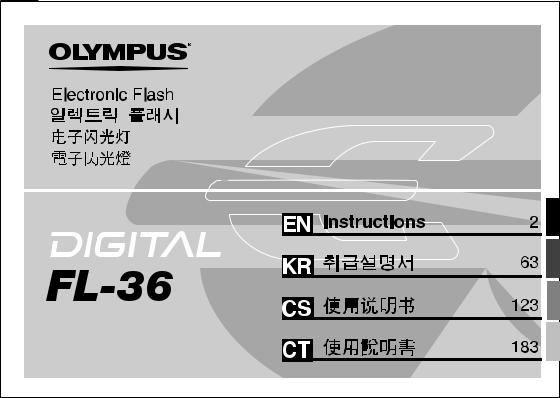
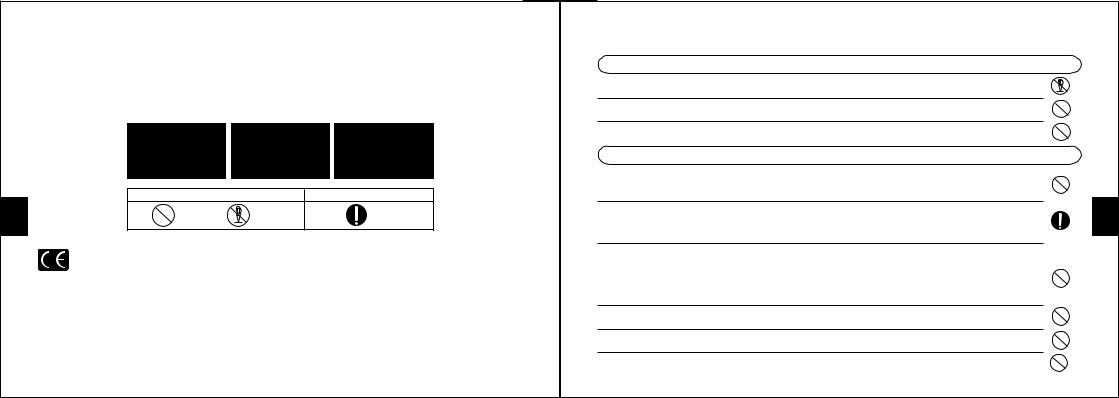
Thank you for purchasing the OLYMPUS Electronic Flash (FL-36). Before use, please read this instruction manual to ensure your safety, and keep it handy for future reference.
SAFETY PRECAUTIONS (Be sure to read and observe the following.)
This instruction manual uses a variety of common symbols and icons to assist you in proper handling and usage of this product properly, and to warn you of potential hazards to yourself and others as well as to property. These symbols and their significance are described below.
 DANGER
DANGER
Failure to observe the precautions indicated by this symbol may result in serious injury or death.
 WARNING
WARNING
Failure to observe the precautions indicated by this symbol may result in injury or death.
 CAUTION
CAUTION
Failure to observe the precautions indicated by this symbol may result in injury or property damage.
Symbols for prohibiting action |
Symbol instructing action |
||
Prohibited |
Disassembly |
Mandatory |
|
prohibited |
|||
|
|
||
For customers in Europe
The “CE” mark indicates that this product complies with the European requirements for safety, health, environment and customer protection. CE-mark products are for sale in Europe.
For customers in USA FCC Notice
This device complies with part 15 of the FCC rules. Operation is subject to the following two conditions:(1) This device may not cause harmful interference, and (2) this device must accept any interference received, including interference that may cause undesired operation.
Any unauthorized changes or modifications to this equipment would void the user’s authority to operate.
For customers in CANADA
This Class B digital apparatus complies with Canadian ICES-003.
2
This electronic flash has been designed exclusively for use with Olympus digital cameras. Do not connect the electronic flash to a camera not manufactured by Olympus, as this may result in a malfunction or damage to the camera and/or flash.
 DANGER
DANGER
The electronic flash incorporates high-voltage circuitry. Never attempt to disassemble or modify it, as this may result in electric shock and/or injury.
Do not use the electronic flash in a place where it may be exposed to flammable or explosive gas. Otherwise, fire ignition or explosion may result.
To prevent a traffic accident, do not direct the flash towards the driver of a car.
 WARNING
WARNING
Do not fire the flash or AF illuminator light immediately in front of a person’s eyes (particularly an infant). Exposure to the light from the flash at a very short range may cause irreparable injury to the eyes. Be especially careful to avoid using the electronic flash at a distance of less than 1 meter from an infant.
Do not leave the electronic flash and batteries within reach of children.
•If a child swallows a battery or small accessory, see a doctor immediately.
• If the flash is emitted near a child, their eyes may be injured irreparably.
• Moving parts of the electronic flash could injure a child.
Avoid the following actions to prevent fire or injury due to battery fluid leak, overheating, fire ignition or bursting.
• Do not use batteries that are not specified for use with this electronic flash.
• Do not throw the battery in a fire, expose it to heat, short-circuit it, or disassemble it.
• Do not mix old and new batteries, or batteries of different types or brands.
• Do not attempt to recharge non-rechargeable batteries such as alkaline batteries.
• Do not load batteries with the +/– polarity reversed.
Do not store the electronic flash in a place exposed to excessive dust or moisture. Otherwise, fire or electric shock may result.
Do not use the flash when it is covered by a flammable object such as a handkerchief. Do not touch the light-emitting area after use. It will be very hot and could burn you.
If the electronic flash is dropped in water or any fluid gets inside, immediately remove the batteries and contact
your dealer or Olympus. Continued use could result in fire or electric shock.
3

 CAUTION
CAUTION
If you notice any abnormalities such as leakage, discoloration, deformation, overheating, or odor, stop using this device. Continued use could result in fire, overheating or explosion. Remove the batteries carefully to avoid burning yourself and to prevent exposure to gas or dangerous fluids that may be released. For repair, contact Olympus.
Always remove the batteries when you don’t expect to use the electronic flash for a long period. Otherwise, heat generation or fluid leak from the batteries may result in fire, injury and/or contamination of the surroundings.
Do not use a leaking battery. Doing so could result in fire or electric shock. Please contact your dealer or Olympus.
Do not handle the electronic flash with wet hands. Doing so could result in electric shock.
Do not leave the electronic flash in a place where it may be exposed to high temperatures. Otherwise, deterioration of parts or fire may result.
Do not take out the batteries immediately after using the electronic flash continuously for a long period. Otherwise, the hot batteries may cause burns.
Do not deform the battery compartment or allow any foreign objects to get inside.
HANDLING PRECAUTIONS
The electronic flash is composed of precision electronic parts. Absolutely avoid using or storing the electronic flash in the following places, as this may result in malfunction or failure.
•Under direct sunlight, on a beach, etc.
•Anywhere exposed to high temperatures and humidity or rapid fluctuations in temperature and humidity.
• Any place exposed to excessive sand, dust or dirt. |
• Near a fire. |
• Near an air conditioner or air humidifier. |
• Any place exposed to water or moisture. |
• Any place subject to vibrations. |
• Inside an automobile. |
Do not apply a strong vibration or shock to the electronic flash by dropping it or hitting it against something.
When the electronic flash has not been used for a long period, mold or moss may form. This can cause a malfunction. To prevent this, it is recommended to check the operations before using the electronic flash after a
4 long period of storage.
Do not touch the electric contacts of the electronic flash to prevent malfunction.
To prevent overheating and deterioration of the light-emitting section, do not continue full activation more than 10 times in a row. After 10 successive operations, stop firing for a while until the light-emitting section cools down.
BATTERY PRECAUTIONS
Use only the specified batteries. (see page 14)
■Be sure to observe the following points. Otherwise, battery fluid leak, overheating, fire ignition and/or bursting may result.
•Do not mix old and new batteries, recharged and discharged batteries, batteries of different capacities, or batteries of different types or brands.
•Do not attempt to recharge non-rechargeable batteries such as alkaline batteries.
•Do not load or use the batteries with the +/– polarity reversed. If the batteries do not fit smoothly in the battery compartment, do not force them.
•Never use a battery if its outer coating (insulation) has been partially or entirely peeled off. Otherwise, leakage, overheating or explosion may result.
•Some brand-new batteries may also have their outer coating (insulation) peeled off completely or partially. Never use these batteries.
■ Do not use the following kinds of batteries.
Outer coating (insulation) is peeling or has peeled off (even if the battery is brandnew).
The negative end is slightly swollen and is not covered by the coating (insulation).
The negative end is flat (whether or not a part of the negative pole is covered by the coating).
■ All rechargeable batteries must be recharged using the specified battery charger, simultaneously and completely. Be sure to read the battery and battery charger instruction manual.
5

■Improper use of batteries may result in fluid leak, heat generation and/or damage. Sweat and oil smudges may cause battery contact failure. To prevent this, remove any stain completely with a dry cloth and insert the batteries by observing the +/– polarity.
■In general, battery performance will be temporarily reduced as the ambient temperature drops. When using batteries in a cold place, keep them warm by keeping the electronic flash in cold protection gear or clothing.
■If battery fluid gets on your skin or clothes, it may irritate your skin. Immediately rinse your skin or clothes with clean water.
■If battery fluid comes in contact with your eyes, blindness may result. Rinse your eyes with clean water without rubbing them and see a doctor immediately.
■Do not apply a strong shock to a battery or throw it.
■When traveling, it is a good idea to carry spare batteries with you. In some countries, it may be difficult to obtain certain batteries.
■Do not immerse batteries in water or expose to moisture including rain, seawater and animal urine.
■If the +/– terminals of a battery are stained with sweat or oil smudges, contact failure may result. Clean the terminals well with a dry cloth before using the batteries.
■Do not throw a battery in fire or heat it.
■When disposing of batteries, be sure to follow local regulations.
■When disposing of a rechargeable battery, insulate the +/– terminals with pieces of tape and take them to your nearest rechargeable battery recycling center.
6
Note on the cameras used with the Electronic Flash
●The functions available from the electronic flash are limited with certain digital cameras. For details, please check the Olympus website (http://www.olympusamerica.com/E1).
Before reading this manual
○The information in this manual may be subject to change without notice.
○This manual has been compiled as carefully as possible. However, if you have any questions or wish to report an error or omission, please contact Olympus.
○Duplication of this manual in part or in whole without permission of Olympus is prohibited except for personal use. Reproduction of the contents of this manual without permission of Olympus is strictly prohibited.
○Olympus will not assume any liability for the damages, loss of profit or claims from any third party incurred due to improper use of this product.
○Olympus will not assume any liability for the damages and loss of profit related to the loss of image data due to a failure of this product, servicing by a third party not designated by Olympus or any other reason.
○Note that the quality of the pictures shot using this product differs from that of the pictures of ordinary film-based cameras.
Trademark information
All brand names and product names mentioned in this manual are the trademarks or registered trademarks of their respective owners.
7
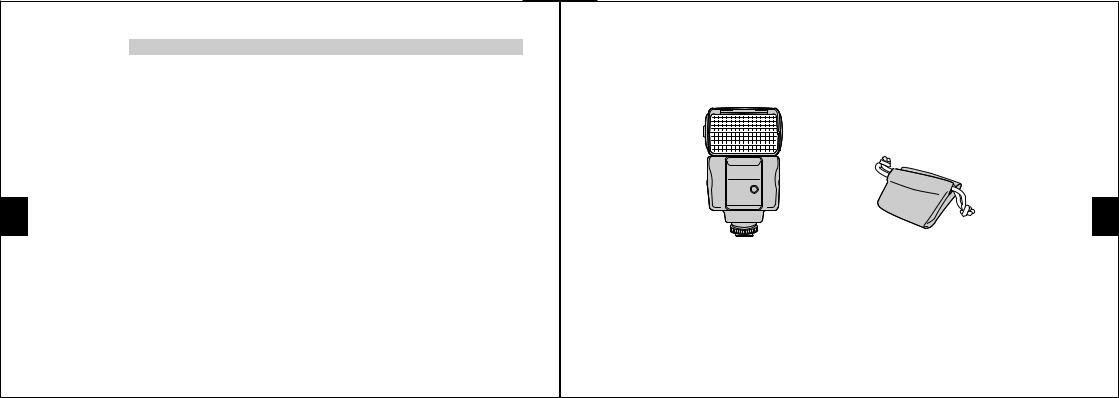
CONTENTS |
|
• Checking the Package Contents .................. |
9 |
• Nomenclature ............................................. |
10 |
• Control Panel Indicators ............................. |
12 |
• Loading Batteries ....................................... |
14 |
• Checking Batteries ..................................... |
16 |
• Attaching to the Camera/Removing from |
|
the Camera ................................................ |
18 |
• Picture Shooting Using a Digital Camera |
|
with Communication Capability ................. |
20 |
Selecting the control mode .................. |
20 |
TTL AUTO ........................................... |
22 |
AUTO .................................................. |
24 |
MANUAL ............................................. |
27 |
FP TTL AUTO ...................................... |
29 |
FP MANUAL ........................................ |
32 |
• Picture Shooting Using a Digital Camera |
|
without Communication Capability ............ |
34 |
8
Selecting the control mode ................ |
34 |
AUTO ................................................. |
35 |
MANUAL ............................................ |
37 |
• Other Operations ....................................... |
39 |
Bounce Shooting ............................... |
39 |
Close-up Flash ................................... |
41 |
Manual Switching of Firing angle (ZOOM) .................. |
42 |
Using the Wide Panel ........................ |
43 |
Various Flash Shooting Methods ....... |
45 |
• Custom Setup ............................................ |
47 |
• All Reset ..................................................... |
50 |
• Continuous Firing ....................................... |
51 |
• Guide Number (GN) List ............................ |
52 |
• Warning Display List .................................. |
55 |
• Q&A ........................................................... |
58 |
• Main Specifications .................................... |
61 |
CHECKING THE PACKAGE CONTENTS 
Check that all parts and accessories are present.
If any item is missing or damaged, contact your dealer.
• Electronic flash, main body |
• Flash case |
• Batteries must be purchased separately.
9
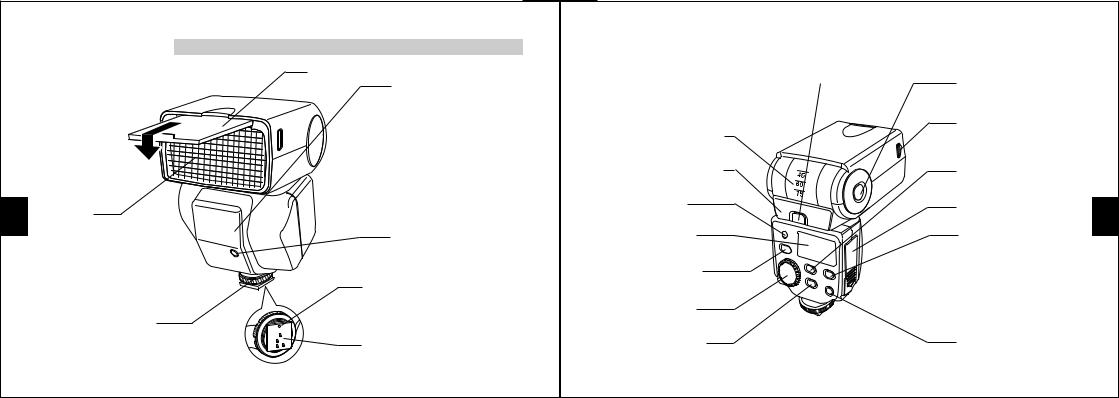
NOMENCLATURE
Wide panel (Page 43)
AF illuminator light-emitting area When the subject is dark or lowcontrast, the built-in AF illuminator emits light to facilitate focusing. The AF illuminator can also be defeated. (Page 47)
• The AF illuminator only works with the Olympus Four Thirds System digital SLR camera. It does not work with other cameras.
Light-emitting area
Auto light receptor
Lock pin (Page 18)
Lock ring (Page 18)
Electric contact (Page 18)
10
Bounce lock release button (left-right direction)(Page 40)
Bounce up/down angle indices (Page 40)
Bounce left/right angle indices (Page 40)
AUTO CHECK lamp (Page 22)
Control panel (Page 12)
Charge lamp/Test button (Page 16)
Select dial (Page 23)
ZOOM button (Page 42)
Bounce lock release button (up-down direction)(Page 40)
Accessory shoe
M O D E b u t t o n (Pages 21 & 34)
Battery compartment cover (Page 15)
LIGHT button
Press to light up the control panel for about 15 sec.
The panel also lights under control by a digital camera with communication capability.
Power button
11
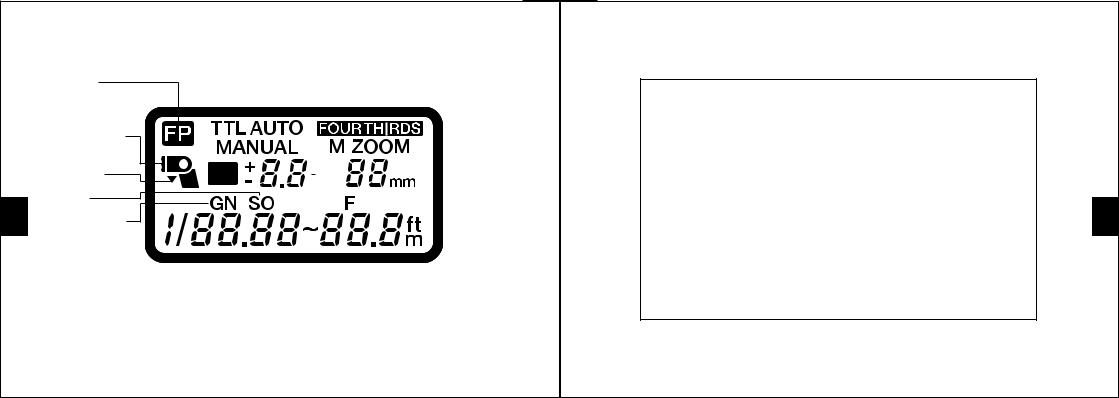
CONTROL PANEL INDICATORS 
FP emission (Pages 29 & 32)
Wide panel warning (Page 43)
Close-up flash shooting (Page 41)
ISO speed (Page 25)
Guide Number (GN)
(Pages 52 & 54)
|
|
Control mode |
Light intensity adjustment |
|
|
|
|
|
||||||||||||||||
|
|
(Pages 20 & 34) |
(Pages 23, 26, 28, 31 & 33) |
FOUR THIRDS |
||||||||||||||||||||
|
|
|
|
|
|
|
|
|
|
|
|
|
|
|
|
|
|
|
|
(Page 47) |
||||
|
|
|
|
|
|
|
|
|
|
|
|
|
|
|
|
|
|
|
|
|||||
|
|
|
|
|
|
|
|
|
|
|
|
|
|
|
|
|
|
|
|
|
|
|
|
Zoom mode |
|
|
|
|
|
|
|
|
|
|
|
|
|
|
|
|
|
|
|
|
|
|
|
|
|
|
|
|
|
|
|
|
|
|
|
|
|
|
|
|
|
|
|
|
|
|
|
|
|
|
|
|
|
|
|
|
|
|
|
|
|
|
|
|
|
|
|
|
|
|
|
|
|
|
(Page 42) |
|
|
|
|
|
|
|
|
|
|
|
|
|
|
|
|
|
|
|
|
|
|
|
||
|
|
|
|
|
|
|
|
|
|
|
|
|
|
|
|
|
|
|
|
|
|
|
|
Zoom value |
|
|
|
|
|
|
|
|
|
|
|
|
|
|
|
|
|
|
|
|
|
|
|
|
|
|
|
|
|
|
|
|
|
|
|
|
|
|
|
|
|
|
|
|
|
|
|
|
|
|
|
|
|
|
|
|
|
|
|
|
|
|
|
|
|
|
|
|
|
|
|
|
|
||
|
|
|
|
|
|
|
|
|
|
|
|
|
|
|
|
|
|
|
|
|
|
|
|
(Page 42) |
|
|
|
|
|
|
|
|
|
|
|
|
|
|
|
|
|
|
|
|
|||||
|
|
|
|
|
|
|
|
|
|
|
|
|
|
|
|
|
|
|
|
|
|
|
|
Lens iris (F) |
|
|
|
|
|
|
|
|
|
|
|
|
|
|
|
|
|
|
|
|
|
|
|
|
|
|
|
|
|
|
|
|
|
|
|
|
|
|
|
|
|
|
|
|
|
|
|
|||
|
|
|
|
|
|
|
|
|
|
|
|
|
|
|
|
|
|
|
|
|
|
|
|
(Page 47) |
|
|
|
|
|
|
|
|
|
|
|
|
|
|
|
|
|
|
|
|
|||||
|
|
|
|
|
|
|
|
|
|
|
|
|
|
|
|
|
|
|
|
|
|
|
|
Feet |
|
|
|
|
|
|
|
|
|
|
|
|
|
|
|
|
|
|
|
|
|
|
|
|
|
|
|
|
|
|
|
|
|
|
|
|
|
|
|
|
|
|
|
|
|
|
|
|
|
|
|
|
|
|
|
|
|
|
|
|
|
|
|
|
|
|
|
|
|
|
|
|
|
|
(Page 47) |
|
|
|
|
|
|
|
|
|
|
|
|
|
|
|
|
|
|
|
|
|
|
|
||
|
|
|
|
|
|
|
|
|
|
|
|
|
|
|
|
|
|
|
|
|
|
|
|
Meter |
|
|
|
|
|
|
|
|
|
|
|
|
|
|
|
|
|
|
|
|
|
|
|
|
|
|
|
|
|
|
|
|
|
|
|
|
|
|
|
|
|
|
|
|
|
|
|
|
|
(Page 47) |
|
|
|
|
|
|
|
|
|
|
|
|
|
|
|
|
|
|
|
||||||
|
|
|
|
|
|
Setting display |
|
|
|
|
|
|||||||||||||
|
|
|
|
|
|
(GN, ISO, F, light control range, optimum shooting |
|
|
|
|
|
|||||||||||||
|
|
|
|
|
|
range, and light intensity adjustment value) |
|
|
|
|
|
|||||||||||||
• To simplify explanation, this figure shows the panel with all indicators lit.
12
Notes on This Manual
•The indications on the control panel may differ from those shown in the illustration above depending on the setup of the electronic flash, the camera in use, and the shooting conditions.
For example, the firing angle (ZOOM) can be displayed in either of the following modes.
FOUR THIRDS : Focal length of a Four Thirds System digital camera135 : Focal length converted to an equivalent angle of view
on a 135 type (35 mm film) camera
The text in this manual employs the FOUR THIRDS display mode and puts value in the 135 display mode inside parentheses, such as “(XX mm with 135)”. For the selection of the display modes, see page 47 .
13

LOADING BATTERIES 
The batteries are available separately. Always use one of the following battery combinations.
• AA (R6) alkaline batteries (LR6 type) ................................... |
x 2 |
|
• AA (R6) |
Ni-Cd batteries ....................................................... |
x 2 |
• AA (R6) |
Ni-Mh batteries ....................................................... |
x 2 |
• AA (R6) Ni-Mn batteries (ZR6 type) ..................................... |
x 2 |
|
• AA (R6) lithium batteries (FR6 type) .................................... |
x 2 |
|
• AA (R6) oxyride batteries (ZR6Y type) ................................. |
x 2 |
|
• Lithium battery pack (CR-V3 type) (Olympus LB-01) ........... |
x 1 |
|
• The AA (R6) manganese batteries cannot be used.
Recommended Batteries
The flash’s charging circuitry is optimized for use with the following batteries:
•AA (R6) Ni-Mh battery
•Lithium battery pack (CR-V3 type) (Olympus LB-01)
14
How to load the batteries
1. Open the battery compartment cover.
2. Insert the batteries with correct +/– polarity.
3. Close the battery compartment cover.
AA (R6) batteries |
CR-V3 |
Notes
•Do not mix old and new batteries or batteries of different types together.
•Remove the batteries when the electronic flash is not going to be used for a long period.
•Carry spare batteries when traveling or when using the flash in cold areas.
15

CHECKING BATTERIES 
After loading the batteries, check the remaining battery capacity by turning the electronic flash on.
1.Press the Power button to turn the electronic flash on.
•The control panel lights up and battery charging starts.
2. Ensure that the Charge lamp lights up. |
|
• Replace the batteries if the time taken for the Charge lamp |
|
to light up is longer than the values specified below. |
|
Alkaline or Ni-Mn batteries: |
30 sec. |
Lithium, Ni-Cd, Oxyride or Ni-Mh batteries: 10 sec.
• If the Charge lamp and AUTO CHECK lamp blink alternately, it means that the battery capacity is running low. In this case, replace the batteries.
|
Memo: To perform test flash activation, press the Test button. |
|
|
|
3. Press the Power button again to turn the electronic flash off. |
|
Turn the electronic flash off in the following cases: |
|
• Before mounting it on the camera or dismounting it from |
|
the camera. |
|
• When flash emission is not required. |
16 |
• When not using the electronic flash. |
|
Flash Interval and Flash Count
The following table shows the flash intervals and flash counts for various batteries. Data is based on using batteries all of the same type.
Batteries used |
Flash interval |
Flash count |
|
|
|
AA (R6) alkaline dry cell batteries (LR6 type) |
Approx. 7.5 sec. |
Approx. 140 times |
|
|
|
AA (R6) Ni-Cd batteries (P3SPS type, 1000 mAh) |
Approx. 6.5 sec. |
Approx. 100 times |
|
|
|
AA (R6) Ni-Mh batteries (HHR-3SPS type, 2230 mAh) |
Approx. 5.5 sec. |
Approx. 200 times |
|
|
|
AA (R6) Oxyride batteries (ZR6Y type) |
Approx. 6.5 sec. |
Approx. 140 times |
|
|
|
AA (R6) lithium batteries (FR6 type) |
Approx. 7.5 sec. |
Approx. 260 times |
|
|
|
CR-V3 lithium battery packs (Olympus LB-01) |
Approx. 6.5 sec. |
Approx. 320 times |
• The flash emission interval and count data were obtained from in-house tests at Olympus.
17
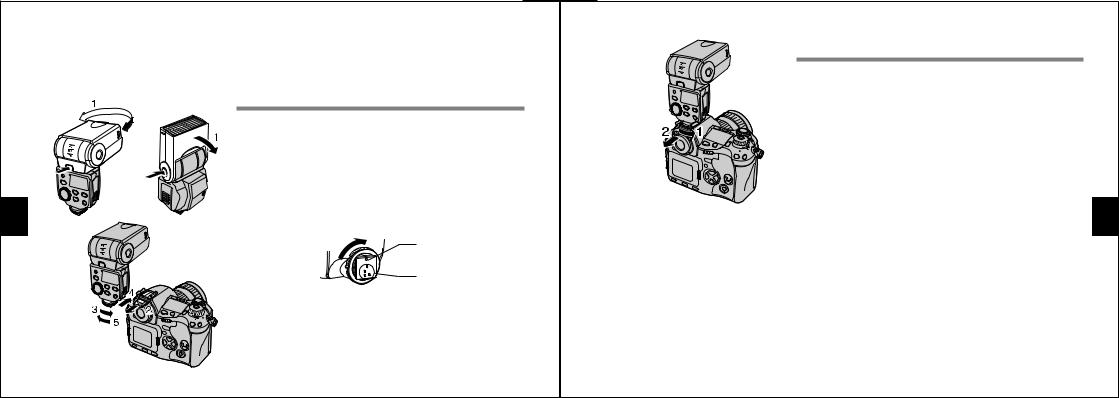
ATTACHING TO THE CAMERA/REMOVING FROM THE CAMERA 
Confirm that both the camera and electronic flash are off.
Attaching or removing the electronic flash while either the flash or the camera is on may result in malfunction.
How to attach
1. Place the light-emitting section in the standard position (horizontal, front). If it is in the locked position, press and turn the Bounce lock release button.
2. Remove the hot shoe cover from the camera.
• Store the hot shoe cover in the pocket located on the inner side of the flash case.
3. Loosen the lock ring.
• If the lock pin is in the out position, press it in by turning it all the way in the opposite direction to [←LOCK] until it stops.
Lock pin
Electric contact
• Do not apply excessive force to the lock pin.
• Do not touch the electric contact with a finger or metallic object.
• Do not attach the electronic flash while the lock pin is in the out position. Otherwise, malfunction may result.
|
4. Slide the electronic flash all the way into the hot shoe until |
|
it stops with a click. |
18 |
5. Turn the lock ring all the way into the direction of [←LOCK] |
until it stops. |
How to remove
1. Loosen the lock ring completely, then slide the electronic flash out of the hot shoe.
2. Attach the hot shoe cover to the camera.
Notes
To use the electronic flash with a digital camera not equipped with hot shoe:
•If the camera has an external flash terminal, the electronic flash can be attached and connected using the flash bracket and bracket cable (optional).
•The electronic flash cannot be used with a camera that is not equipped with a hot shoe or external flash terminal.
19
